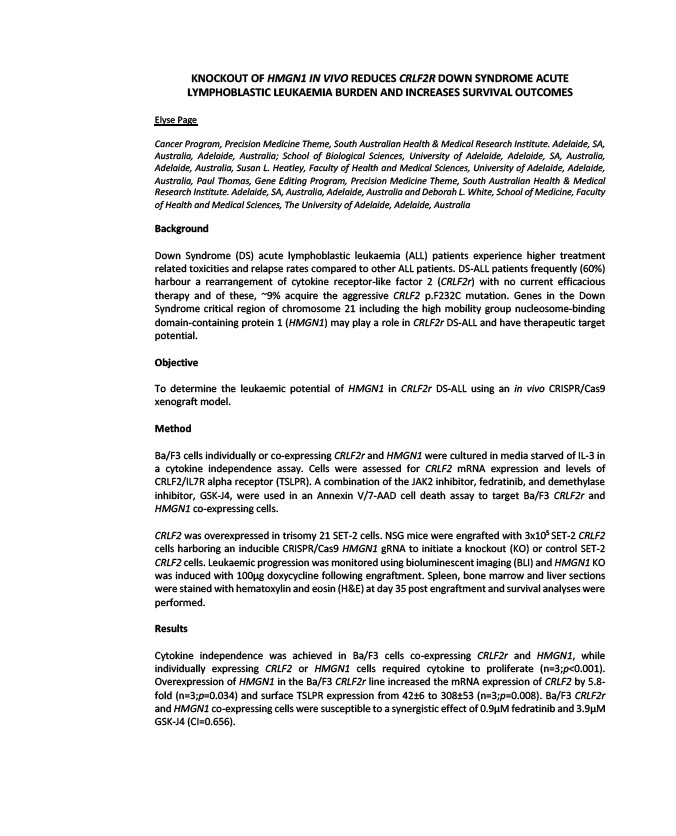
KNOCKOUT OF HMGN1 IN VIVO REDUCES CRLF2R DOWN SYNDROME ACUTE
LYMPHOBLASTIC LEUKAEMIA BURDEN AND INCREASES SURVIVAL OUTCOMES
Elyse Page
Cancer Program, Precision Medicine Theme, South Australian Health & Medical Research Institute. Adelaide, SA,
Australia, Adelaide, Australia; School of Biological Sciences, University of Adelaide, Adelaide, SA, Australia,
Adelaide, Australia, Susan L. Heatley, Faculty of Health and Medical Sciences, University of Adelaide, Adelaide,
Australia, Paul Thomas, Gene Editing Program, Precision Medicine Theme, South Australian Health & Medical
Research Institute. Adelaide, SA, Australia, Adelaide, Australia and Deborah L. White, School of Medicine, Faculty
of Health and Medical Sciences, The University of Adelaide, Adelaide, Australia
Background
Down Syndrome (DS) acute lymphoblastic leukaemia (ALL) patients experience higher treatment
related toxicities and relapse rates compared to other ALL patients. DS-ALL patients frequently (60%)
harbour a rearrangement of cytokine receptor-like factor 2 (CRLF2r) with no current efficacious
therapy and of these, ~9% acquire the aggressive CRLF2 p.F232C mutation. Genes in the Down
Syndrome critical region of chromosome 21 including the high mobility group nucleosome-binding
domain-containing protein 1 (HMGN1) may play a role in CRLF2r DS-ALL and have therapeutic target
potential.
Objective
To determine the leukaemic potential of HMGN1 in CRLF2r DS-ALL using an in vivo CRISPR/Cas9
xenograft model.
Method
Ba/F3 cells individually or co-expressing CRLF2r and HMGN1 were cultured in media starved of IL-3 in
a cytokine independence assay. Cells were assessed for CRLF2 mRNA expression and levels of
CRLF2/IL7R alpha receptor (TSLPR). A combination of the JAK2 inhibitor, fedratinib, and demethylase
inhibitor, GSK-J4, were used in an Annexin V/7-AAD cell death assay to target Ba/F3 CRLF2r and
HMGN1 co-expressing cells.
CRLF2 was overexpressed in trisomy 21 SET-2 cells. NSG mice were engrafted with 3x105 SET-2 CRLF2
cells harboring an inducible CRISPR/Cas9 HMGN1 gRNA to initiate a knockout (KO) or control SET-2
CRLF2 cells. Leukaemic progression was monitored using bioluminescent imaging (BLI) and HMGN1 KO
was induced with 100μg doxycycline following engraftment. Spleen, bone marrow and liver sections
were stained with hematoxylin and eosin (H&E) at day 35 post engraftment and survival analyses were
performed.
Results
Cytokine independence was achieved in Ba/F3 cells co-expressing CRLF2r and HMGN1, while
individually expressing CRLF2 or HMGN1 cells required cytokine to proliferate (n=3;p<0.001).
Overexpression of HMGN1 in the Ba/F3 CRLF2r line increased the mRNA expression of CRLF2 by 5.8-
fold (n=3;p=0.034) and surface TSLPR expression from 42±6 to 308±53 (n=3;p=0.008). Ba/F3 CRLF2r
and HMGN1 co-expressing cells were susceptible to a synergistic effect of 0.9μM fedratinib and 3.9μM
GSK-J4 (CI=0.656).